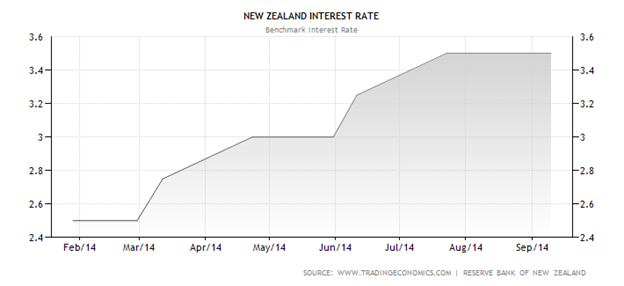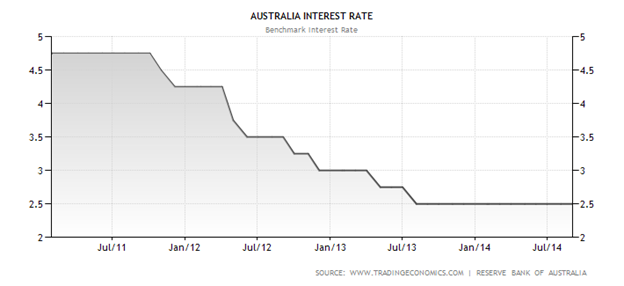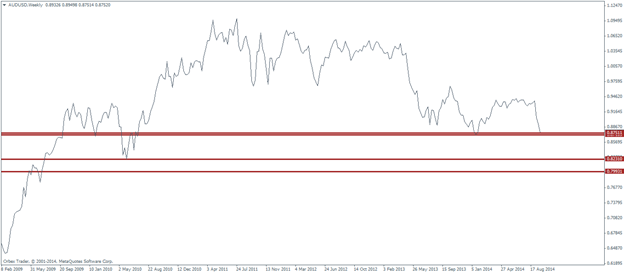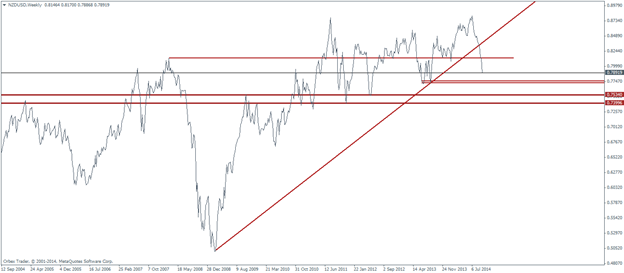Ask any trader on what their preferred positions would be in regards to the AUD and the NZD against the Greenback and the answer would be to be on the long side. Considering that both these commodity currencies come with a higher interest rate of 2.5% and 3.5% respectively, even for the average retail trader, the idea of gaining some additional profits through overnight swaps makes these currencies a prime candidate for carry trades. If only things were that simple. The Aussie and the Kiwi dollar are often subject to verbal interventions by their respective Central Bank Governors and at times from other members of the monetary policy board as well.
Until a few months ago, the NZDUSD enjoyed a broad based rally supported by the RBNZ’s interest rate hike path since March this year, rising rates from 2.5% through3.5%.
RBNZ Overnight Cast Rate Hike

Source: Tradingeconomics.com
The Reserve Bank of Australia on the other hand has pledged to maintain interest rates steady at 2.5% after cutting gradually cutting interest rates since 2011. Despite the rate cut, Australia’s interest rates still stand at an attractive 2.5% among the other major currencies.
RBA Interest Rates

Source: Tradingeconomics.com
What has prompted the verbal intervention?
Lower exchange rate against the US Dollar has been one of the prime topics of global central banks. Ever since the US Federal Reserve embarked on its easy monetary policy, the Greenback had declined against most of its peers sparking similar actions from other central bankers, either in the form of launching their own QE or verbally intervening in the markets to drive the exchange rate lower. For countries such as Australia and New Zealand, having a lower exchange rate helps drive their exports industry as these two countries rely heavily on exports in industries such as meat, dairy and minerals.
In regards to the Australian Dollar, the economy which has close trade ties with China is often susceptible to fluctuations of demand from their Chinese counterparts. Recent fundamental data and views expressed by the Chinese show that they are ready to accept a slowdown in their GDP growth, which had hitherto enjoyed one of the fastest GDP growth. A slowdown from China and having a higher exchange rate against the US Dollar would definitely pose some major headwinds to any recovery the Australian economy could expect.
Likewise, in the case of the Kiwi which relies on exporting its dairy also finds a higher exchange rate debilitating its dairy exports.
Inflation is another aspect that has been a tricky path. Australia currently experiences a 2.8% inflation rate while New Zealand’s inflation has been steadily rising to 1.6%. The RBA’s monetary policy currently targets an inflation rate between 2 & 3% while RBNZ’s target is to maintain inflation between 1 & 3%. While further rate hikes have been ruled out in the near term, rising inflation could pose serious threats to both these economies, which on the other hand could be controlled by mere verbal threats to talk down their respective exchange rates.
AUD & NZD – Technical Levels
For traders watching the AUDUSD and NZDUSD, the following two charts gives a longer term view of the markets.
AUDUSD

The weekly charts of AUDUSD shows price currently near a short term support level that was formed in early January this year. A break of this support level could see price head lower to target the next price level at 0.823 levels. The outlook of course needs to be supported by strong US economic data.
NZDUSD

The NZDUSD is currently poised to test the short term support regions of 0.774 having broken the trend line. We can expect to see a rally towards the 0.81355 levels for a second retest and a potential break of support at 0.774 to target 0.753.
To conclude, while the AUD and NZD might have made for a good carry trade candidates, the fact that they are ever so often hammered down by their respective central bank chiefs makes it a risky proposition to be on the buy side for these pairs. There might be a few opportunities every now and then, but given the technical and fundamental views, both these commodity currencies are likely to go lower. After all, you can’t really go against the Central bankers can you?
